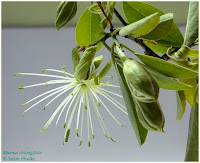


Casuarina equisetifolia
A small family of two genera and 65 species confined to the southern hemisphere from South East Asia to northeast Australia. In India the family is represented by single genus and single species which occurs on east side of Bay of Bengal from Chittagong southwards and also cultivated in several parts of India.
Horse-tail tree (Casuarina equisetifolia) is the familiar example of the family.
Vegetative characters:
They are much branched evergreen trees or shrubs of xerophytic habit with long or short, green , cylindrical and striate, whorled and jointed branches. The internodes of branches are furrowed. The leaves are in whorls of four to sixteen depending upon the species. They are small scale like linear lanceolate and are always basally connate forming a sheath surrounding the node.
Inflorescence and flowers:
The flowers are unisexual and the trees are monoecious or dioecious.
The male flowers are born in catkin like spikes which are terminal at the end of the green branchlets. At each of node of the Inflorescence axis there are several flowers protected by a sheath formed of the combined bracts. The stamens hang out over the edge of the sheath.
The female flowers are crowded in dense spherical or ovoid heads at the ends of the short lateral branches. The perianth is absent and the flowers are naked. The gynoecium is bicarpellary and syncarpous with a superior ovary.
Fruits and seeds:
The fruit is a samaroid indehiscent nut enclosed by persistent woody bracteoles which separate on maturity. The fruits are aggregated into a dry woody cone- like multiple fruit. The seeds are nonendospermic with straight embryo and flat cotyledons.
Pollination is by wind. Seed dispersal of Casuarina equisetifolia is by sea.
Economic importance:
The wood of several species of Casuarina is valued for hardness. The wood of Casuarina equisetifolia is known as ironwood. Some species are grown for ornament.







